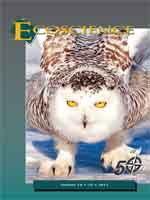This review provides a synthesis of limnological data and conclusions from studies on ponds and small lakes at our research sites in Subarctic and Arctic Canada, Alaska, northern Scandinavia, and Greenland. Many of these water bodies contain large standing stocks of benthic microbial mats that grow in relatively nutrient-rich conditions, while the overlying water column is nutrient-poor and supports only low concentrations of phytoplankton. Zooplankton biomass can, however, be substantial and is supported by grazing on the microbial mats as well as detrital inputs, algae, and other plankton. In addition to large annual temperature fluctuations, a short growing season, and freeze-up and desiccation stress in winter, these ecosystems are strongly regulated by the supply of organic matter and its optical and biogeochemical properties. Dissolved organic carbon affects bacterial diversity and production, the ratio between pelagic and benthic primary productivity via light attenuation, and the exposure and photoprotection responses of organisms to solar ultraviolet radiation. Climate warming is likely to result in reduced duration of ice-cover, warmer water temperatures, and increased nutrient supplies from the more biogeochemically active catchments, which in turn may cause greater planktonic production. Predicted changes in the amount and origin of dissolved organic matter may favour increased microbial activity in the water column and decreased light availability for the phytobenthos, with effects on biodiversity at all trophic levels, and increased channelling of terrestrial carbon to the atmosphere in the form of greenhouse gases.
How to translate text using browser tools
1 September 2011
Shallow Freshwater Ecosystems of the Circumpolar Arctic
Milla Rautio,
France Dufresne,
Isabelle Laurion,
Sylvia Bonilla,
Warwick F. Vincent,
Kirsten S. Christoffersen
ACCESS THE FULL ARTICLE

Ecoscience
Vol. 18 • No. 3
September 2011
Vol. 18 • No. 3
September 2011
Arctic ponds
bacteria
bactéries
changements climatiques
climate change
étangs arctiques
primary producers




